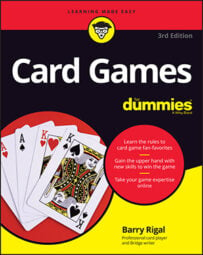After each new hand is dealt in a game of Spades, starting with the player on the dealer's left, each player bids any number of tricks between 0 and 13. The combined total for each side is the number of tricks that the partnership needs to take to fulfill its contract for the hand.
Each partnership registers its tricks as a unit — it doesn’t matter whether you or your partner takes the tricks unless a bid for nil has been made by one of the players; the important thing is that your side gets them.
When you pick up a hand, consider your high cards and your trump length to try to estimate the value of the hand. There will be imponderables, of course, but the initial calculation is linked to those two factors.
For example, with the hand shown in this figure, you bid two, counting one trick for the Ace of Hearts and one for the spades. Note that the Ace of Hearts is probably a trick you do not have to win; you have enough hearts to be able to refrain from playing that card on a heart lead. So you have some flexibility as to whether you want to bid one or two with the example hand. With the King of Clubs, you would bid three tricks. If you take this basic starting hand and change the 9 of Clubs to the King of Spades, the hand is worth four tricks: three in spades and the Ace of Hearts.

Dealer’s choice
Being the dealer in Spades is a significant advantage because you get to hear the other players commit themselves to a number of tricks before you have to decide on a bid.
As a player in fourth seat, you hear the three players suggest a combined total. As a general rule, you shouldn’t take the total to more than 13. At an early stage in the game, consider, for example, that your opponents have jointly contracted for six tricks, and your partner has bid for three. If you make five tricks and your partner makes his three, then you have already combined to set your opponents by stopping them from making their announced target of six. Because you have already achieved a major target on the hand, you’re better off bidding four and settling for an overtrick if it accrues. Yes, your side takes a small hit, but you administer a bigger blow to the opponents in the process. Conversely, if you really need to set the opponents to have a chance to win the game, you may bid five if you’re truly confident — however, the penalty of the overtrick may be too severe.
As a general rule, if you have a strong hand and the player to your left bids strongly, you should go low because that player will be in a position to capture your kings and queens if he so desires. If the player to your right bids strongly, the reverse applies; you’re in the catbird seat.
Bidding for nil
You can bid for zero tricks if you think your hand really stinks. A bid of nil carries additional benefits and liabilities. The concept is to make no tricks at all, and you get a generous 50-point bonus for success (with an equally heavy penalty for failure).
Normally, the two players on a team combine their bids to form a total contract for their side. If you bid nil, however, your success or failure depends on your own personal performance. Although your partner does his best to help you by overtaking any high cards that you play, making the contract is up to you and you alone.
If one player bids nil, his partner’s bid still stands. That player must make his bid good in the usual fashion, with the standard bonuses and penalties applying.
A more unlikely option is to blind nil, which carries with it the same concept of not taking any tricks, but you make the bid without looking at your hand. The rewards and penalties are doubled (so the consequence is plus or minus 100 points). You can only attempt the blind nil option if your side is 100 or more points behind. Because bidding blind nil is a highly risky strategy, you should attempt it only as a last resort. It’s also helpful to remember that it may be better for your side to be down 100 rather than 90 points because of this option.
Because going blind is such a difficult feat to achieve, the player making the call can exchange two cards with his partner to improve both players’ hands for their various purposes. The cards are passed face-down, and the bidder passes his two cards first, letting his partner look at the cards and select two from his own hand in exchange.
When your partner bids blind nil, you should protect it, even at the potential cost of not making your contract. When you lead to the first trick, start with high cards from your long suits, which lets him discard on later rounds of the suit. Consider not overtaking your opponent’s high cards, even if you think you may need the trick to make your bid, to make sure you’re left with enough high cards to protect your partner. If you lead to the first trick on your own nil, consider starting with a middle card in a short suit — the odds are that your partner will be able to overtake.

